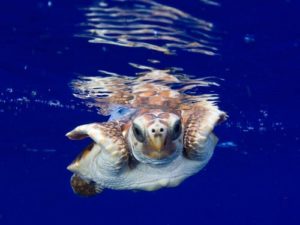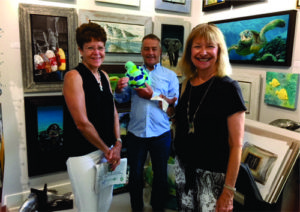Introducing “Theo of South Walton” Sea Turtle
By Dee Cruce

It was a gorgeous morning in the month of September in Blue Mountain Beach when little Theodora, the loggerhead sea turtle, boiled out of her nest with her turtle brethren, foggy-eyed but hopeful, and made her way across the sand to the water to begin her life-long adventure. No bigger than a tennis ball, the little turtle began paddling out to sea on her way to catchthe North Atlantic Subtropical Gyre (NASG). An ocean current, much like a huge lazy river that circulates all over the Atlantic, was an easy ride for Theo to the Sargasso Sea. Here she would spend much of her childhood safe and warm hanging out in the large floating seaweed communities known as Sargassum.


Alas, a young turtle can only hang out for so long. Now seven years old, it was a season of adventure and time to see the world. See the world, she did. She spent years in the Bahamas and among islands off the coast of Portugal and Africa. She made friends and sunned herself atop the gulf. All the while, she pondered her future and day-dreamed about one day returning back to the sugar-white sand she scampered across all those moons ago. These were her “lost years” of coming of age.
Having spent many years in the ocean now, Theo grew concerned about her environment. It was becoming more and more often that she saw large mounds of plastic bags floating about posing as seed weed. She often saw wayward bags off on their own looking a great deal like the jelly fish she enjoyed eating. The coral reeves she enjoyed visiting were changing as well. She knew something must be done before it was too late and her life’s mission was beginning to unfold.
By now, you are wondering where all this is going, right? By giving you a little background story, South Walton Life and the Friends of South Walton Sea Turtles (FSWST) are proud to introduce a new voice to our beach community, Theo the Sea Turtle. While our beautiful beaches are home and known to vacationers from all over the world, they are also home to many species of sea turtles who have long visited during our summer season and their nesting season to lay eggs in the sand they hatched from. From May through October, mother turtles are coming to the beach.
In an effort to preserve turtle nests and the species, as well as educate our local community and tourists who visit our beaches, Theo has made her way back to Walton County with a mission in mind. We must keep our beaches #Clean.Dark.Flat and we must keep doing our part to educate the masses. To support this very important mission, we’ve created a Theo Plushy that can be obtained for a donation at various locations on 30-A all summer. The proceeds will go toward additional local sea turtle community education programs, as well as advertising and media campaigns that will help us keep the message of #Clean.Dark.Flat going. In case you are wondering what this clean dark and flat business is all about, allow me to explain. In an effort to help our returning sea turtles do their egg laying, we need to keep the beach clean. Remove your trash after a day in the sun and keep the beach as CLEAN as you found it. Be mindful of recycling plastic products such as bags, bottles, straws, cups, etc., or opt for paper or cheap reusable bags. Plastic products are finding their way into our waters and are often mistaken as food by our sea turtles, birds and fish. A 2015 study led by the University of Queensland, estimates that 52 percent of sea turtles worldwide have eaten plastic debris, some 13 million tons of which is dumped into the ocean every year. The east coasts of Australia and North America, Southeast Asia, southern Africa and Hawaii seem to be particularly dangerous.
Trash, chairs, boogie boards and more left on the beach are an obstacle for a foggy-eyed momma turtle. Sea turtles are near-sighted on land and often struggle to maneuver around debris left behind. They also can’t go in reverse on land which brings me to my next point; FLAT. Anytime you go to the beach, you’ll find children and even adults building sand castles, and digging holes for tent and umbrella installation. Now all this is good fun, but we must cover those holes, and smash our castles at the end of the day. Castles are an obstacle to maneuver around and loggerheads have been found in holes on our beaches. Were it not for our diligent South Walton Turtle Watch walkers, a holed turtle would surely die. It takes at least 20 years for a turtle to reach reproduction age. Let’s think about that. If they’re on the beach, it is just to lay eggs in the dark.
Dark…that’s right. The turtles come in at night, so as not to be disturbed, and lay their eggs in the sand. Let’s be mindful to keep our lights out at night and not confuse them. Are you getting it now? Clean…Dark…Flat.
You’ll be seeing a lot more of Theo and #Clean.Dark.Flat in South Walton this Summer and now you’ll know what it’s all about. So, join in the fun, look for and report a Theo sighting and be eligible for a special prize from one of Theo’s sponsors. Purchase a Theo at out Charter Sponsor, Pecan Jacks Ice Cream and receive a free scoop of “Theo of South Walton” Ice cream, a special flavor especially designed for Theo.Turtley awesome! Don’t forget to tell them Theo sent ya and stay tuned for more Theo sightings in the future. Have a great summer and be safe out there!

Be the first to comment on "Introducing the Adventures of Theo the Sea Turtle"